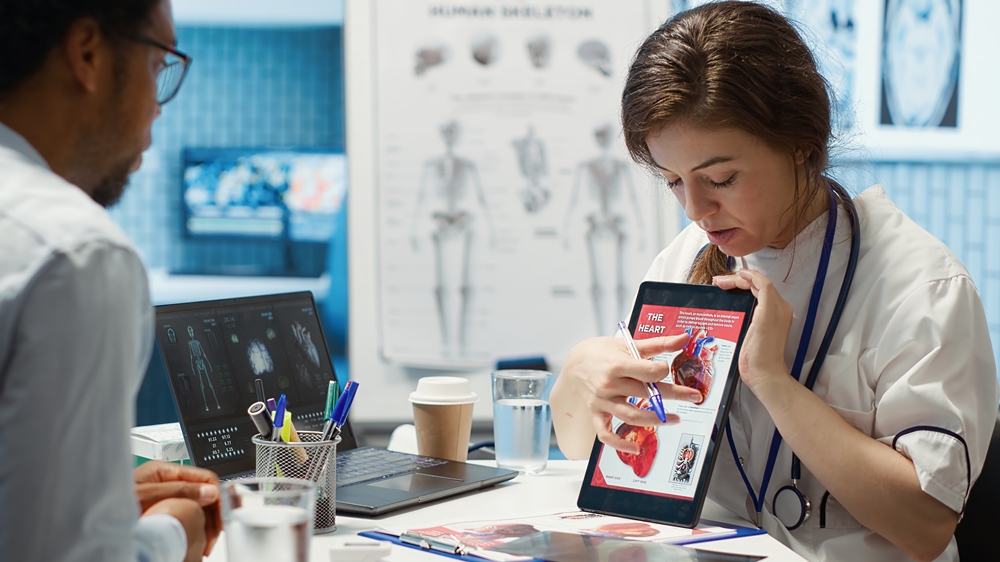News
UK aims for 92 per cent dementia diagnosis by 2029

The UK government has announced a plan to diagnose 92 per cent of people with dementia within 18 weeks of a doctor’s referral by 2029 — up from fewer than half today.
A £5m research challenge will fund new diagnostic tools, including blood tests, saliva analysis and AI-driven technologies, to speed up detection and improve care for the one million people living with dementia in the UK.
The announcement was made by science minister Lord Vallance during a visit to the UK Dementia Research Institute in Cambridge with health minister Dr Zubir Ahmed on 24 October.
Potential solutions include blood tests that detect the build-up of abnormal proteins in the brain — a hallmark of dementia that damages nerve cells — and saliva analysis to identify hormonal changes linked to early memory decline. Such innovations could move diagnosis away from traditional tests based on visible cognitive symptoms.
AI-powered daily assistants could also support people through smart speakers or tablets, learning their routines and cognitive abilities. These tools could suggest brain exercises, give task reminders, assist with recipes or connect users with family members via video calls.
With one in four acute hospital beds in England occupied by someone with dementia, these developments aim to help more people receive care in their communities while reducing pressure on the NHS. The number of people with dementia is projected to reach 1.4m by 2040.
“Few people in the UK will go through life untouched by the impact of dementia – whether through a personal diagnosis or by caring for a loved one,” said Lord Vallance.
“We must therefore grasp the opportunities that science and technology offer in getting people the early and effective diagnosis they need to continue living fulfilled lives while reducing the pressure on hospitals.”
Health minister Dr Zubir Ahmed said: “For too long, our health system has struggled to support those with complex needs, including the one million people living with dementia. This ambitious challenge represents a crucial step forward in our mission to build an NHS fit for the future.
“By harnessing the power of innovation to diagnose dementia faster and more accurately, we can ensure patients and their families get the support they need earlier, when it can make the greatest difference.”
The Dementia Patient Flow R&I Challenge is the third of five to be launched under the R&D Missions Accelerator Programme, backed by £500m from the Spending Review and coordinated by UK Research and Innovation (UKRI).
UKRI has also announced £1.2m for two projects accelerating innovation in digital cognitive assessments. Kneu Health, a University of Oxford spinout, will develop smartphone-based cognitive assessment technology that combines digital testing with biomarker analysis — measuring molecules in the body that indicate illness.
Food for the Brain Foundation will receive funding for a web-based test assessing four key brain functions: thinking speed, memory, recognition and decision-making.
The test can be completed in clinics and at home using standard web browsers before being integrated into NHS services.
Professor Siddharthan Chandran, director and chief executive of the UK Dementia Research Institute, said: “As a practising neurologist, I see first-hand the devastating impact that a long delay for diagnosis can have on an individual and their family. We’re now at an inflection point.
“The next five years will see a revolution in both therapeutics and diagnostics for dementia, and we’re already seeing the beginnings of that transformation today.
“Precise, early diagnosis isn’t just about giving people information — it’s about giving them agency, choice, and crucially, access to emerging clinical trials and treatments that offer real hope to slow or stop these conditions.”
Hilary Evans-Newton, chief executive at Alzheimer’s Research UK, said: “This funding focus is a welcome boost to UK dementia research, which is already helping to lead the way on cutting-edge tests to detect dementia, through major initiatives like the Blood Biomarker Challenge, which is validating blood tests, and the Dame Barbara Windsor Dementia Goals programme, which brings together industry, academia and the NHS.
“Right now, hundreds of thousands of people living with dementia miss out on a diagnosis – and the answers, care and support that one can bring. That’s not just a crisis. It’s wrong.
“But innovations like blood tests, digital assessments and retinal scans are offering real hope, and they will soon be here.”
News
Lack of free time could increase dementia risk

A lack of free time could be raising dementia risk, with researchers calling for action on ‘temporal inequity’ to protect brain health.
A new perspective article from the University of New South Wales (UNSW) in Australia argues that ‘time poverty’ – not having enough discretionary time – may limit people’s ability to prevent dementia, particularly among women and lower-income groups.
The researchers say people need sufficient time to support brain health through exercise, sleep, nutrition and social connection.
“Up to 45 per cent of dementia cases worldwide could be prevented if modifiable risk factors were eliminated,” says epidemiologist Susanne Röhr.
“However, many people simply don’t have the discretionary time to exercise, rest properly, eat healthily, or stay socially connected.
“This lack of time – what we call ‘time poverty’ – is a hidden barrier to dementia risk reduction.”
The team estimates that around 10 hours a day are required for brain-care activities such as adequate sleep, healthy eating, physical activity and social interaction.
Yet, the pressures of modern life – from work demands to caring responsibilities – often make this unrealistic.
Women face particular challenges, handling most caregiving duties globally, while lower-income workers often have to work longer or irregular hours, further reducing their free time.
“For many, especially those in disadvantaged or caregiving roles, this simply isn’t achievable under current conditions,” says psychology researcher Simone Reppermund.
“Addressing time poverty is therefore essential if we are serious about preventing dementia.”
The researchers call for broader social measures, including improved childcare, more flexible work arrangements such as four-day work weeks, better public transport and the right to disconnect from work.
They warn that if such steps are not taken, dementia rates will continue to rise, with the greatest impact on disadvantaged populations.
“Brain health policy and research have focused heavily on individual behaviour change,” says neuropsychiatrist Perminder Sachdev.
“But unless people are given the temporal resources to act on these recommendations, we risk leaving behind those who need it most.
“Just as governments act on income inequality, we need to act on temporal inequity.”
The researchers add that dementia-related lifestyle risks – such as loneliness, poor diet, inadequate sleep, lack of exercise and poor oral hygiene – all require time to manage effectively.
They say this highlights a shift from focusing solely on personal choice to recognising the wider structural barriers that stop people from reducing their dementia risk, even when they know what to do.
News
Research reveals potential ‘two-in-one’ treatment for diabetes and heart disease

A new experimental drug called IC7Fc could help treat both diabetes and heart disease by lowering cholesterol and reducing inflammation in the arteries, researchers have found.
In tests on mice prone to cardiovascular disease, the drug significantly reduced blood fats (triglycerides) and cholesterol while slowing the build-up of fatty deposits in arteries that can cause heart attacks and strokes.
Building on earlier studies showing IC7Fc’s benefits for type 2 diabetes, the international research suggests the treatment may target both metabolic and cardiovascular disease.
The work was led by Leiden University Medical Center in the Netherlands, in collaboration with Monash University and other institutions.
IC7Fc works by reducing atherosclerosis — the narrowing and hardening of arteries caused by fatty plaque build-up.
This process limits blood flow to vital organs and is a major cause of cardiovascular events.
Professor Mark Febbraio from the Monash Institute of Pharmaceutical Sciences said: “Our earlier studies showed IC7Fc could help manage type 2 diabetes, a metabolic disease.
“This new research shows it can also reduce atherosclerosis, meaning it slows the ‘clogging’ of the arteries, where fatty deposits build up and restrict blood flow to the heart,” said
“Heart disease remains the world’s biggest killer, driven largely by atherosclerosis. Even with common treatments that lower blood pressure and cholesterol, many people are still at risk, showing there’s more work to do.”
Earlier studies found IC7Fc reduced appetite and body fat in obese mice.
However, in this new study using lean mice prone to high cholesterol and artery disease, the drug did not affect body weight or food intake.
This suggests IC7Fc’s weight-loss effects may mainly apply to obesity, while its heart-protective benefits — such as reducing cholesterol build-up in arteries — could also help lean individuals.
The findings highlight the drug’s potential as a versatile treatment and the need for further research in humans.
“These results suggest IC7Fc could offer a dual benefit — helping reduce obesity in some, while protecting the heart in others,” Professor Febbraio said.
“It’s an exciting step towards a treatment that targets both metabolic and cardiovascular disease.”
Professor Febbraio has been central to the discovery and long-term research into IC7Fc as a potential treatment for metabolic diseases.
The research team is now planning human trials to test whether the same benefits can be replicated in patients.
Insights
Creativity helps keep the brain young, study finds

Tango dancers have brains that appear more than seven years younger than their actual age, with creativity linked to slower brain ageing across all art forms, new research has found.
Musicians and visual artists showed brains about five to six years younger, while gamers’ brains appeared around four years younger, according to research examining how creative activities affect brain health.
The more participants practised their art form, the stronger the anti-ageing effect.
“Creativity protects brain areas that are vulnerable to ageing and makes brain communication more efficient,” said Carlos Coronel, postdoctoral researcher at the Latin American Brain Health Institute.
He compared the effect to “building more, larger, and higher-quality roads to communicate between cities within a country.”
Researchers collected data from almost 1,400 people across 13 countries, including expert tango dancers, musicians, visual artists and gamers, and non-experts matched for age, education and gender.
The work, led by the Latin American Brain Health Institute at Universidad Adolfo Ibáñez and Trinity College Dublin, used artificial intelligence “brain clocks” to estimate brain age.
Brain clocks are AI models that estimate how old a brain appears based on scans or patterns of neural activity.
When someone’s predicted brain age is lower than their chronological age, it suggests their brain is ageing more slowly and functioning more efficiently for their years.
The researchers recorded brain activity using magnetoencephalography and electroencephalography — techniques that measure electrical activity in real time.
They then trained computer models to create a brain clock for each participant.
Even short-term creative training produced benefits. Non-experts who trained for 30 hours in the strategy video game StarCraft II showed a reduction in brain age of between two and three years.
The team also used “digital brains” — biophysical computer simulations that replicate real brain activity using mathematical equations — to understand why creativity may protect against ageing.
These models showed that creative activities help key brain areas work better together, especially regions involved in focus and learning that typically age first.
Professor Agustín Ibáñez from Trinity College Dublin said the research “reframes creativity as a biological pathway to brain health and resilience, not only a cultural or psychological phenomenon.”
The findings suggest that creativity keeps connections between brain regions stronger and more flexible, particularly in areas that usually decline with age.
It did not matter which art form participants practised — dancing, painting, music or gaming all showed similar effects.
“By showing that artistic engagement can delay brain ageing, this research helps us reimagine the role of creativity in education, public health, and ageing societies,” the researchers said.
They described creativity as a “scalable, accessible and deeply human mechanism” to sustain cognitive and emotional wellbeing across diverse populations and lifespans.
Unlike many brain health interventions, creative activities also provide enjoyment alongside biological benefits.
“Your next dance step, brush stroke, or musical note might just help your brain stay a little younger,” the researchers concluded.

 News2 months ago
News2 months agoThousands in England unable to access weight loss jabs via NHS, figures reveal

 Research1 month ago
Research1 month agoBrain shape changes could offer early warning signs of dementia, study suggests

 News4 days ago
News4 days agoEthnic minorities more likely to underreport health problems, research finds

 Wellness2 months ago
Wellness2 months agoRound up: First AI-powered app for longevity and more

 Insights3 weeks ago
Insights3 weeks agoHigh fat diet may keep brain young, study suggests

 News1 month ago
News1 month agoNHS warns against dismissing symptoms as ‘natural part of ageing’

 Insights2 weeks ago
Insights2 weeks agoWeight loss drug reduces heart attack and stroke risk regardless of weight loss

 News2 months ago
News2 months agoAir pollution can drive devastating forms of dementia, study suggests





























